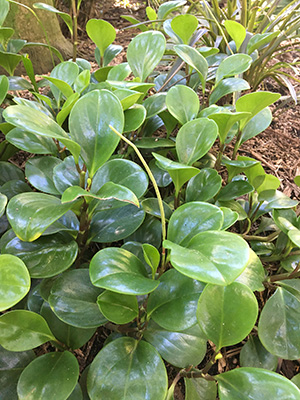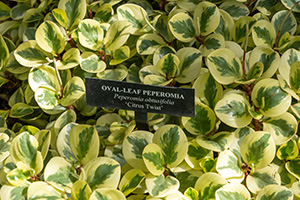Florida Peperomia
This native’s shiny ornamental foliage makes it an excellent addition to your home or landscape.

Florida peperomia (Peperomia obtusifolia), also called baby rubber plant, is perfect for filling shaded areas as a groundcover or atop a shelf as a houseplant.
Characteristics
The Peperomia genus includes over 1000 species of plants native to tropical and subtropical areas. Many are succulent-like and have fleshy leaves that can store water. They prefer indirect light and are relatively slow growing.
True to its name, Florida peperomia is perfectly suited for our humid, warm climate. It can even be seen growing in bogs in the Everglades, but is considered endangered. As an outdoor plant, it grows best in Central and South Florida.
Florida peperomia is a small, bushy, upright plant that grows 6 to 12 inches tall and spreads 1 to 2 feet wide. It has waxy, round, evergreen leaves and unique blooms. Its miniscule green-white flowers grow along the surface of reddish, leafless stems about 5 inches long. The blooms are interesting, but not showy, and appear periodically throughout the year when grown outside. When grown as a houseplant, blooms rarely appear. The fruits are small, brown and oval.
There are various cultivars of Florida peperomia popular in the market, including ‘Marble’, which has leaves with variably sectored patterns of dark green, creamy white and grayish green. ‘Minima’ is a dwarf cultivar, half the size of the species. ‘Variegata’ has dark green and grayish green leaves bordered by creamy white.
Planting and Care
Florida peperomia can be grown in USDA Hardiness Zones 10 through 11 and can be planted year-round. One highlight of this plant is its tolerance for shade. It’s difficult to find turfgrass that can grow in shaded environments, so a groundcover might be a better option. Florida peperomia fits the bill, thriving in low-light conditions in both partial and deep shade. Placing this plant in direct sunlight will burn the leaves, so be sure to stick to filtered light.

With low maintenance requirements, Florida peperomia is easy to care for. It can grow in most soils, but prefers rich, organic soils. It is drought tolerant and needs well-drained conditions to prevent stem and root rot. When watering, less is more; Florida peperomia does better with slightly dry soil.
This Florida native does well in containers or raised beds and makes a great indoor plant. It has a tendency to cascade over the sides of hanging baskets, making it an attractive and calming addition to your porch or patio.
Long-term health of Florida peperomia is generally unaffected by pests and disease, but some short-term issues include mites and leaf spot disease. These problems can be avoided with proper care. For propagation, use cuttings, which root easily. Divisions can also be used.
Besides Florida peperomia, some other peperomia plants grown in Florida as houseplants include watermelon peperomia (Peperomia argyraea), emerald ripple peperomia (P. caperata), ivy-leaf peperomia (P. griseoargentea), red-edge peperomia (P. clusiifolia), and false-philodendron peperomia (P. scandens).
This compact plant with decorative foliage can make a pleasant addition to your yard or home. If you’ve been looking for a groundcover for your shady areas, Florida peperomia is an ideal choice for Central and South Florida gardeners. For more options, see the Gardening Solutions article Groundcovers for Shade.
